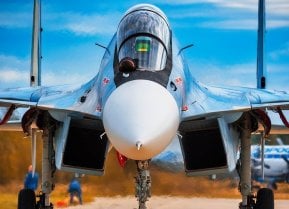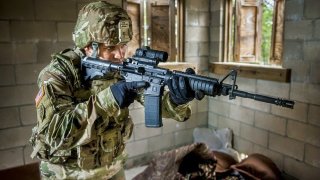Delta Force: They Might Be the Best Special Forces Unit on Earth
By all accounts, Delta Force is a tight community – a brotherhood whose members always run toward the gunfire and are in Delta to be deployed for as many missions as possible.
Summary: Delta Force, officially known as 1st SFOD-D, is a Tier One U.S. Army special operations unit specializing in counter-terrorism, hostage rescue, direct action, and other high-stakes missions. Tasked by Joint Special Operations Command, Delta has been pivotal in operations like the raid on ISIS leader Abu Bakr al-Baghdadi in 2019. Formed by Colonel Charlie Beckwith in the late 1970s after experiencing British SAS operations, Delta Force's rigorous selection and training process prepares operators for the most demanding tasks. Despite its secrecy, glimpses into their operations reveal a group dedicated to executing the U.S.'s most critical military interventions. With evolving capabilities, including undersea drones and advanced communications, Delta Force remains at the forefront of U.S. military operations, embodying a blend of tactical excellence and innovation.
Inside Delta Force: America's Elite Counter-Terrorism Unit
You know it as Delta Force, but the operators call themselves the Combat Applications Group, CAG, D-Boys, the Dark Side, the Other Side of the Fence, Task Force Green, or simply the Unit.
Officially, it’s the U.S. Army’s First Special Forces Operational Detachment-Delta (1st SFOD-D).
This is a Tier One special operations group. To maintain secrecy on army budget documents, the line item is often referred to as Army Compartmented Elements (ACE).
Delta Force: What Do They Do?
Delta Force excels at hostage rescue, targeted elimination or apprehension of terrorists, close-quarter combat, direct action raids, intelligence collection, irregular warfare, and VIP guarding.
Elements of Delta Force are continuously on standby for orders from their umbrella command – the Joint Special Operations Command (JSOC). JSOC can deploy Delta anywhere in the world.
A Brief History That Isn’t Classified
While it is impossible to know the types of missions Delta Force has conducted over the years, they are believed to have been the main element in the raid on Abu Bakr al-Baghdadi, the leader of ISIS.
In October 2019, Delta conducted Operation Kayla Mueller, to remove al-Baghdadi from the battlefield. Al-Baghdadi later detonated an explosive vest and killed himself during the raid.
Never shy of a gunfight, Delta pulled numerous operations in Iraq and Afghanistan as you would expect. One noteworthy statistic was that by 2009, “the casualty rate for the Delta command was 20 percent and 50 percent of the operators that went to Iraq received a Purple Heart,” according to SOFREP.com. Delta also participated in the Battle of Mogadishu in 1993, which went on to be portrayed in the book and movie Black Hawk Down.
In my opinion, SOFREP.com has the best profile of Delta Force, so I will depend on this source in the following passages.
How Did the Unit Come About?
In the late 1970s, the army was interested in creating its own special operations group that would carry out more direct action raids against the enemy – something that U.S. Army Special Forces did not always conduct, as the Green Berets were set up for training and fighting beside indigenous units during the Vietnam War.
In 1977, the Pentagon tasked Colonel Charlie Beckwith, who had been in Special Forces and had spent time with the British Special Air Service, to stand up a new, more focused unit.
Beckwith spent the next two years setting up Delta Force, which would be focused on counter-terrorism and missions the rest of the special operations units could not accomplish easily. Beckwith and his subordinates created a six-month selection program for volunteers. Training and tests put volunteers through difficult, long-range land navigation exercises and other tasks that would prepare them physically and mentally.
In 1980, Delta was given a difficult mission – rescue 53-American hostages held in Tehran. This was known as Operation Eagle Claw, and it was unsuccessful for several reasons. The main element of Delta operators did not reach the building holding the hostages. But Delta used lessons learned from Eagle Claw to improve and adapt.
How Are They Organized?
Delta Force is believed to be task-organized into several squadrons split down into “troops.” Each squadron has three troops for assault purposes. There is a clandestine intelligence and reconnaissance squadron, and an aviation squadron, plus combat support units such as signals, medical, and intelligence analysis.
How Can You Try Out for Delta Force?
As you could imagine, becoming a Delta operator is a long, difficult process. Selection is open to anyone with a rank of Specialist (E-4) and Captain (E-3). Trainees must be 21-years-old or older. Most people who go to selection are either in the Ranger Regiment or Ranger-Qualified or in Army Special Forces. Many of these operators have numerous back-to-back deployments to Iraq and Afghanistan.
The selection process is classified and changes as combat needs evolve. One book – Inside Delta Force – describes intense, long-range land navigation courses to evaluate physical attributes. Then the trainee must pass a complicated mental evaluation period that includes psychological interviews and oral performances in front of boards. Roughly 10-percent of each class is selected.
If selected, the trainee goes on to a six-month Operator Training Course. This is comprised of several units of skills development from clearing rooms and close-quarter combat to picking locks and improvising explosives. The counter-terrorism missions and hostage rescue operations are rehearsed. There is even a block of instruction on espionage tradecraft that is likely similar to CIA clandestine officer training.
Remember, selection and training are classified and constantly changing and evolving depending on the needs of Delta and JSOC.
My Experience with Delta Force
My experience with Delta Force is limited of course. I was not a member of special operations forces during my service in the army, although I was once attached to a Special Forces battalion as a public affairs specialist. I have seen Delta operators train using All-Terrain Vehicles at Camp Dawson, West Virginia.
A mountainous land navigation course I completed, also at Camp Dawson, was said to take place on a Delta Force training ground. I had a friend who was selected and assigned to a Delta squadron who abruptly told one of my special ops buddies, “I can never talk to you anymore.” I never heard from or saw this Delta operator again. I hope he is still alive. That’s the level of secrecy that Delta develops in its operators.
By all accounts, Delta Force is a tight community – a brotherhood whose members always run toward the gunfire and are in Delta to be deployed for as many missions as possible. They believe that the more gunfights they engage in, the better. We should feel fortunate they are willing to be the tip of the spear and fight the battles no one else can.
About the Author
Brent M. Eastwood, PhD, is the author of Humans, Machines, and Data: Future Trends in Warfare. He is an Emerging Threats expert and former U.S. Army Infantry officer. You can follow him on Twitter @BMEastwood.
All images are Creative Commons.


